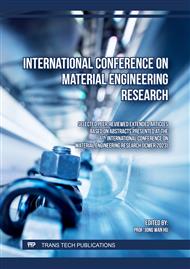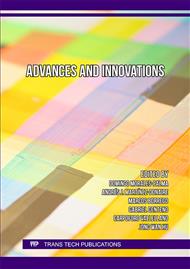[1]
Bouadila, S., Kooli, S., Lazaar, M., Skouri, S., & Farhat, A. (2013). Performance of a new solar air heater with packed-bed latent storage energy for nocturnal use. Applied Energy, 110, 267-275.
DOI: 10.1016/j.apenergy.2013.04.062
Google Scholar
[2]
Tan, N. P. B., Ucab, P. M. L., Dadol, G. C., Jabile, L. M., Talili, I. N., & Cabaraban, M. T. I. (2022). A review of desalination technologies and its impact in the Philippines. Desalination, 534, 115805.
DOI: 10.1016/j.desal.2022.115805
Google Scholar
[3]
Majid, Z. A. A., Ruslan, M. H., Sopian, K., Othman, M. Y., & Azmi, M. S. M. (2014). Study on performance of 80 watt floating photovoltaic panel. J. Mech. Eng. Sci, 7(1), 1150-1156.
DOI: 10.15282/jmes.7.2014.14.0112
Google Scholar
[4]
Tian, Y., & Zhao, C. Y. (2013). A review of solar collectors and thermal energy storage in solar thermal applications. Applied energy, 104, 538-553.
DOI: 10.1016/j.apenergy.2012.11.051
Google Scholar
[5]
Al-Ahmad, A. Y., Clark, D., Holdsworth, J. L., Vaughan, B., Belcher, W. J., & Dastoor, P. C. (2022). An Economic LED Solar Simulator Design. IEEE Journal of Photovoltaics, 12(2), 521-525.
DOI: 10.1109/jphotov.2022.3143460
Google Scholar
[6]
López-Fraguas, E., Sánchez-Pena, J. M., & Vergaz, R. (2019). A low-cost LED-based solar simulator. IEEE Transactions on Instrumentation and Measurement, 68(12), 4913-4923.
DOI: 10.1109/tim.2019.2899513
Google Scholar
[7]
Mellit, A., & Benghanem, M. (Eds.). (2020). A Practical Guide for Advanced Methods in Solar Photovoltaic Systems. Springer.
Google Scholar
[8]
Terliesner, S., Kaufmann, E., Grott, M., & Hagermann, A. (2022). A Simple Way of Simulating Insolation on a Rotating Body with a Commercial Solar Simulator. International J. Thermophysics, 43(7), 1-10.
DOI: 10.1007/s10765-022-03027-8
Google Scholar
[9]
Sun, C., Jin, Z., Song, Y., Chen, Y., Xiong, D., Lan, K., ... & Zhang, M. (2022). LED-based solar simulator for terrestrial solar spectra and orientations. Solar Energy, 233, 96-110.
DOI: 10.1016/j.solener.2022.01.001
Google Scholar
[10]
Ding, W., Zhou, Y., Gu, M., Gong, J., & Xu, J. (2022). Thermal Characteristic of Novel Insulation Materials Designed for Solar Simulator. Energies, 15(13), 4831.
DOI: 10.3390/en15134831
Google Scholar
[11]
T anesab, J., Ali, M., Parera, G., Mauta, J., & Sinaga, R. (2019, October). A Modified Halogen Solar Simulator. In ICESC 2019: Proceedings of the 1st International Conference on Engineering, Science, and Commerce, ICESC 2019, 18-19 October 2019, Labuan Bajo, Nusa Tenggara Timur, Indonesia (p.9). European Alliance for Innovation.
DOI: 10.4108/eai.18-10-2019.2289851
Google Scholar
[12]
Jung, I. S., Choi, J., Shah, D. K., & Akhtar, M. S. (2020). Development and Characterization of Solar Simulator for Solar Cells. Journal of Nanoelectronics and Optoelectronics, 15(6), 720-724.
DOI: 10.1166/jno.2020.2802
Google Scholar
[13]
Dipasquale, D., Brunello, P., Zarella, A., Pertile, M., & Debei, S. (2019). Numerical characterization of a solar simulator. In 37th UIT Heat Transfer Conference.
Google Scholar
[14]
Samir, A., Mahgoub, A., Eliwa, A., Atia, D. M., El-Madany, H. T., El-Metwally, K., & Zahran, M. (2020). Design and implementation of LED solar simulator. WSEAS Trans. Power Syst., 15, 68-78.
DOI: 10.37394/232016.2020.15.8
Google Scholar
[15]
Yandri, E. (2018). Uniformity characteristic and calibration of simple low-cost compact halogen solar simulator for indoor experiments. International Journal of Low-Carbon Technologies, 13(3), 218-230.
DOI: 10.1093/ijlct/cty018
Google Scholar
[16]
Tawfik, M., Tonnellier, X., & Sansom, C. (2018). Light source selection for a solar simulator for thermal applications: A review. Renewable and Sustainable Energy Reviews, 90, 802-813.
DOI: 10.1016/j.rser.2018.03.059
Google Scholar
[17]
Lawin, A. E., Niyongendako, M., & Manirakiza, C. (2019). Solar irradiance and temperature variability and projected trends analysis in Burundi. Climate, 7(6), 83.
DOI: 10.3390/cli7060083
Google Scholar
[18]
International Electrotechnical Commission. (2008). Photovoltaic devices—Part 3: measurement principles for terrestrial photovoltaic (PV) solar devices with reference spectral irradiance data. IEC 60904–3 ed2.
DOI: 10.3403/00319123
Google Scholar
[19]
Rosli, M. A. M., Hamizan, M. A. D., Nawam, M. Z., Fazli, M. F. A., Saleem, S. N. D. N., Noh, N. M., & Hussain, F. (2022). A Study of Spectral Match and Spatial Non-uniformity for Indoor Solar Simulator. In International Conference and Exhibition on Sustainable Energy and Advanced Materials (pp.230-235). Springer, Singapore.
DOI: 10.1007/978-981-19-3179-6_41
Google Scholar
[20]
Cortés‐Severino, R., Cárdenas‐Bravo, C., Barraza, R., Sánchez‐Squella, A., Valdivia Lefort, P., & Castillo‐Burns, F. (2021). Optimal design and experimental test of a solar simulator for solar photovoltaic modules. Energy Science & Engineering, 9(12), 2514-2528.
DOI: 10.1002/ese3.985
Google Scholar
[21]
Arifin, Z., Kuncoro, I. W., & Hijriawan, M. (2021). Solar simulator development for 50 WP solar photovoltaic experimental design using halogen lamp. International Journal of Heat and Technology, 39(6), 1741-1747.
DOI: 10.18280/ijht.390606
Google Scholar
[22]
Bindu, S., Soofi, A., Askins, S., Vallerotto, G., Dominguez, C., & Antón, I. (2022, September). Solar simulator for indoor characterization of hybrid CPV/flat-plate modules. In AIP Conference Proceedings (Vol. 2550, No. 1, p.020001). AIP Publishing LLC.
DOI: 10.1063/5.0102699
Google Scholar
[23]
Napat Watjanatepin, P. K. (2021). A Novel Solar Simulator Based on Combined Natural-White and Infrared Light Emitting Diodes. Journal of Southwest Jiaotong University, 56(5).
DOI: 10.35741/issn.0258-2724.56.5.53
Google Scholar
[24]
Liu, G., Ning, J., Gu, Z., & Wang, Z. (2021, March). Stability Test on Power Supply to the Xenon Lamp of Solar Simulator. In Journal of Physics: Conference Series (Vol. 1820, No. 1, p.012142). IOP Publishing.
DOI: 10.1088/1742-6596/1820/1/012142
Google Scholar
[25]
Chu, S., Bai, F., Nie, F., & Wang, Z. (2021). Description and Characterization of a 114-kWe High-Flux Solar Simulator. Journal of Solar Energy Engineering, 143(1).
DOI: 10.1115/1.4047295
Google Scholar



